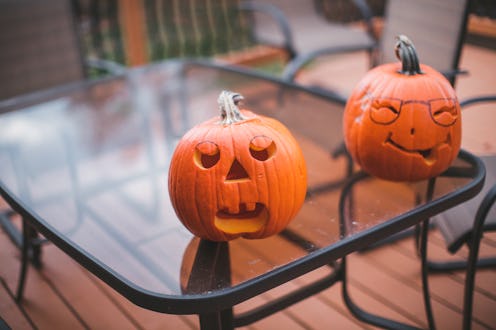Life
The History Of Jack-O'-Lanterns Is Creepy

With Halloween looming, it’s time to get a pumpkin, scrape out its guts, and use a knife to carve scary faces into its orange flesh. When you think about it, carving jack-o-lanterns is a pretty weird (and sort of gruesome) practice. Why do we do it? The history of jack-o-lanterns is more interesting — and creepy — than you might think, rooted in Irish folklore about a dude who makes the mistake of trying to trick the Devil. Turns out, that’s not a great idea.
Although people have been using gourds as make-shift lamps for many centuries (The Maori have been doing so for 700 years), jack-o-lanterns arose from Irish folklore about a figure named “Stingy Jack,” dating back as far as five or six centuries. As with much folklore, there are multiple versions of the Stingy Jack legend, but the main story goes that Stingy Jack invited the Devil to have a drink, and then decided he didn’t want to pay for it. Jack convinced the Devil to turn himself into a coin that Jack could use to buy drinks, after which Jack promptly put Satan-as-a-coin into his pocket with a silver cross, preventing the Devil from returning to his true form. Eventually, Jack let Satan out of his coin-shaped prison, but made him promise that he’d leave Jack alone for a year and not take Jack to Hell if he died.
After a year, Jack met Satan again and convinced him to climb up a tree in pursuit of fruit. (Why do I get the impression that the Devil is not the sharpest tool in the shed?) Jack trapped Satan in the tree by carving a cross on its bark (because apparently it is super easy to trick the soul of all evil), and made him promise to leave Jack alone for another decade.
Eventually, Stingy Jack died. Unsurprisingly, God refused to allow such a stingy, duplicitous guy into heaven, and Satan, understandably, refused to let him anywhere near Hell. The Devil gave Jack a burning coal and left him to wander the Earth indefinitely. Jack put the coal in a lantern made out of a turnip, and the creepy, wandering dead guy with his vegetable lamp became known as “Jack of the Lantern,” or simply “Jack-O-Lantern.”
In Ireland, Scotland, and England, people started making lanterns out of large potatoes, turnips, and even beets, with scary faces carved into them. They’d put the lamps in their windows to ward off evil sprits (and Stingy Jack himself). (Just check out the 19th-century jack-o-lantern housed in Ireland, above. Something about the turnip skin makes it way scarier than our usual pumpkins). When Irish immigrants came to America, they brought the lore of Stingy Jack with them, and found that pumpkins make perfect lanterns. And that’s why you’re spending your Saturday scooping out the goopy guts of a gigantic orange squash and trying to carve out a face without maiming yourself.
So, two lessons from this history: One, you shouldn’t try to trick Satan, even if he isn't all that sharp. Two, turnips can be legit terrifying.
Images: Annie Otzen/DigitalVision/Getty Images; Giphy; Rannpháirtí anaithnid/Wikimedia